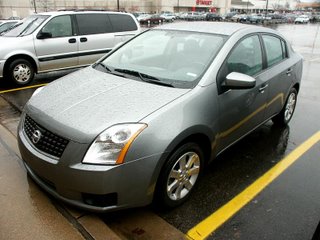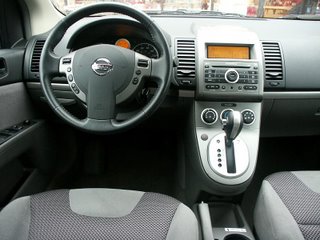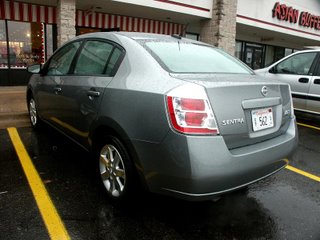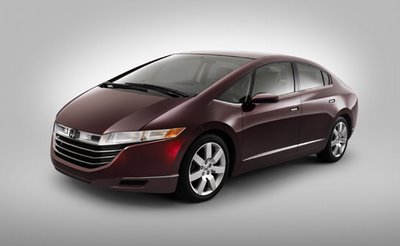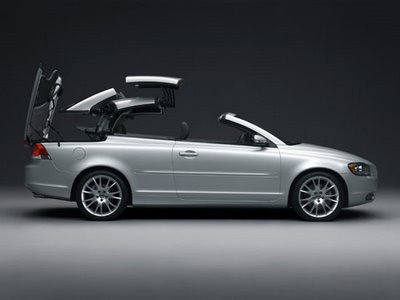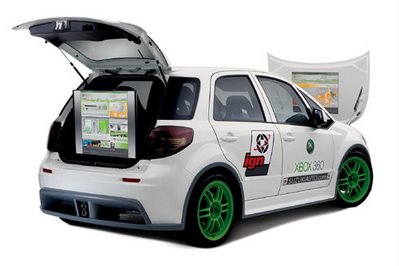
To reinforce its commitment to providing fun-to-drive vehicles for lifestyle-driven consumers, American Suzuki Motor Corporation (ASMC) brings its "game face" to the 2006 Los Angeles Auto Show, showcasing two exceptional activity-oriented concepts, and its full-line of versatile cars and SUVs, including the all-new XL7 midsize crossover SUV and the bold and functional SX4 compact X-over (crossover). All new for 2007, the XL7 and SX4 already have made a positive impression with media and consumers.
ASMC is enjoying record sales success in 2006, with total year-to-date sales up an impressive 25 percent through the first ten months vs. 2005, led by the redesigned Grand Vitara and the all-new XL7 and SX4, which recently arrived in dealer showrooms.
To further support the launch of Suzuki's two new vehicles, ASMC has developed a line of 2007 XL7 and SX4 "Suzuki LIVE Series" concept vehicles. At this year's Los Angeles Auto Show, Suzuki will debut its SXBox, a modified SX4 concept designed for ultimate game fanatics, and BaseCamp, an XL7 concept built specifically for outdoor adventure enthusiasts. To showcase the SXBox's gaming capabilities, Suzuki will host a video game challenge on Nov. 29. Additionally, professional gamer Patrick "Indigo Ferret" Wyrick will be onsite at the Suzuki booth to provide last-minute video game counsel on the featured video game, Project Gotham 3.
"We developed the 2007 'Suzuki LIVE Series' to showcase the excitement of the all-new XL7 and SX4. We took our production vehicles and created a number of unique concept vehicles personalized to fit consumers' active lifestyles," said Gene Brown, vice president of marketing and PR, ASMC. "The implementation of brand-building marketing initiatives, such as these one-of-a-kind, lifestyle-based concept vehicles, provide the ongoing framework for Suzuki's evolving brand identity."
"Suzuki LIVE Series" VehiclesLast year, American Suzuki Motor Corporation (ASMC) launched the "Suzuki LIVE Series" (LIFE VEHICLES) -- a line of brand-dedicated concept vehicles specially designed for life enthusiasts, adventurers and thrill-seekers. In concert with its "Way of Life" brand proposition, which promises products for active lifestyles, and to support the launch of the all-new XL7 and SX4, ASMC introduces four all-new "Suzuki LIVE Series" vehicles for 2007, illustrating how its cars and SUVs play an integral part of consumers' everyday life.
The vehicles, coined BaseCamp for outdoor adventure enthusiasts; Flix for film and entertainment buffs; Zuk for motorcycle and racing aficionados; and SXBox for avid gamers; will be on display at various auto shows and lifestyle events around the country.
SXBoxBuilt by ASC of Huntington Beach, Calif., and based on the all-new SX4 compact sport X-over, the SXBox is designed for ultimate video game enthusiasts. The Suzuki SX4 concept receives mild performance upgrades, including high-flow airbox/intake, cat-back exhaust, an enhanced suspension and multi-piston alloy brake calipers mated to cross-drilled, vented rotors.
The SXBox also is equipped with an impressive, high-performance wheel and tire package, providing gamers with the means to get to the nearest gaming competition. When parked, the SXBox's pearl white exterior is illuminated courtesy of a green LED accent kit.
The interior design of the SXBox features an ultra-high-tech, game-inspired color scheme throughout the inside of the vehicle, including recessed LED emitters to brighten the interior of the vehicle. The SXBox is outfitted with a dashboard-integrated Xbox 360 gaming console, coupled with a close proximity digital projection system to display enthusiasts' game of choice on the interior of the vehicle's retractable hood, easily enabled by the push of a button. A second Xbox 360 video game system powers two separate LCD display screens in the seat backs of the SXBox to provide gaming excitement for rear passengers. For gamers who prefer to stand and play, the SXBox is equipped with a 30-inch retractable rear projection screen in the cargo area.
Adding comfort and convenience to the idea of in-car gaming, the concept vehicle features high-relief, force-feedback front seats with game-station highlights to create a snug gaming environment and four wireless controllers, including a steering-wheel-mounted gaming control for the driver. In addition, the SXBox's multi-speaker surround audio system with wide frequency response and thundering bass provides an intense atmosphere of video game stimulation.
BaseCampBuilt by the Carlab of Orange, Calif., and based on the all-new 2007 XL7, the BaseCamp concept offers cutting-edge design and technology to fulfill the needs of outdoor adventure enthusiasts. The BaseCamp's exterior is blanketed with liquid metal body paint and finished with titanium cladding around the perimeter, which also is easily converted to a catwalk for unprecedented upper vehicle access and storage.
The concept features a unique gullwing passenger side door that, when opened, reveals a warm, inviting, modern interior and attachable peninsula bar work station with full media connectivity, including Wi-Fi Internet access, Bluetooth integration and iPod(1)/MP3 capabilities. The BaseCamp also features a custom roof rack system with an integrated dual slot bike rack and Santa Cruz mountain bikes, eight high-intensity LED light clusters, including a unique "down" lighting system, an enclosed cargo/luggage area and forward-mounted miniature camera. After arriving at a campsite, a modern canopy with carbon fiber frame can be attached to the roof rack, keeping adventurers dry in inclement weather or protecting against the sun, and creating a welcoming ambiance for visitors.
The BaseCamp's interior reflects a similar high-tech design and feel with mica-hued light-toned seating and titanium accents throughout the inside of the vehicle. In the rear cargo area, the vehicle features a utility storage pack and access system. Additionally, the XL7 concept is equipped with in-dash CD/DVD and GPS/Navigation system with real-time traffic.
2007 Suzuki XL7The all-new XL7 blends SUV versatility, style and safety, and features available all-wheel drive and seven-passenger, three-row seating to provide adaptability for active, mobile lifestyles. The 3.6-liter, V6, DOHC engine delivers 252 horsepower and 243 lb.-ft. of torque, and is matched to a five-speed automatic transmission with manumatic controls.
The XL7 has a long list of standard features, including a five-speed automatic transmission with manumatic shift, extensive safety features, including four airbags, tire pressure monitoring system (TPMS), ABS with electronic brake-force distribution (EBD), traction control system (TCS) and Electronic Stability Program (ESP)(2). Additional standard features include remote keyless entry, tilt steering wheel, power windows, door locks and mirrors, two 12-volt accessory outlets, cruise control, 16-inch alloy wheels, satin silver trim, air conditioning with automatic climate control, trip computer, automatic headlamps, AM/FM/CD audio system with six speakers and privacy glass.
Three trim levels are offered: XL7, Luxury and Limited. Offered in five- and seven-passenger configurations and either front-wheel drive or available all-wheel drive, XL7 has a starting manufacturer's suggested retail price (MSRP) of $22,899. The XL7 Luxury adds leather-appointed interior, power driver seat, heated front seats, wood trim accents and 17-inch alloy wheels and has a starting MSRP of $24,599.
The top-of-the-line XL7 Limited features standard seven-passenger seating and adds fog lamps, rear spoiler, upgraded roof racks with aluminum lower bumper valances, premium XM Satellite Radio-ready audio system with seven speakers (including subwoofer), auto-dimming rearview mirror with compass, remote starter and DVD entertainment system. The feature-packed XL7 Limited carries an MSRP of $27,949.
There are three optional packages to go with the three trim levels: A seven-passenger seating package (available on XL7 and XL7 Luxury); a DVD entertainment package (available on three-row Luxury) that features a DVD entertainment system with wireless headphones and remote starter system; and a Platinum Touring package featuring a touch-screen navigation system, 17-inch chrome-plated alloy wheels with unique design and sunroof.
2007 Suzuki SX4The 2007 Suzuki SX4 compact sport X-over (crossover), recently named "Best Kept Secret of 2007" by Autobytel, is designed for those who live an adventurous life and is sure to be a year-round standout in any driving conditions. The all-new SX4 (the name stands for (S)port (X)-over for (4) seasons of weather) features a handsome five-door hatchback design, a sophisticated standard all-wheel-drive system, excellent stability and crisp handling characteristics. Built in Japan, the SX4 features a sophisticated 2.0-liter, in-line four cylinder, 16-valve DOHC engine rated at 143 horsepower. SX4 is also fitted with intelligent all-wheel drive (i-AWD) as standard equipment. The i-AWD system operates in three modes for maximum fuel economy on dry pavement or to facilitate traction in case of snow or mud.
The SX4's standard features include six airbags; front driver and passenger airbags, driver and passenger side-impact airbags and side-curtain airbags; four-wheel ABS with EBD, TPMS, seatbelt pretentioners, power windows, locks and mirrors, remote keyless entry, air conditioning, AM/FM/CD/MP3 audio system with four speakers, tilt steering wheel, 16-inch alloy wheels, black roof rails, daytime running lights, fender flares and silver bumper guards. SX4 carries an MSRP of $14,999.
The SX4 comes in two trim levels: SX4 and SX4 Sport. SX4 is available with a Convenience Package, which includes cruise control, leather-wrapped steering wheel and steering-wheel-mounted audio controls. SX4 Sport includes: TCS and ESP, auto temperature control, cruise control, leather-wrapped steering wheel and steering-wheel-mounted audio controls, premium audio with six-disc CD changer and nine speakers (including subwoofer), silver-color roof rails and SmartPass keyless entry and start system. SX4 Sport has an MSRP of $16,399. All trim levels are available in manual or automatic transmission with standard AWD.
2007 Suzuki Grand VitaraFirst introduced as a 2006 model, the Grand Vitara has garnered much media and consumer praise and has won numerous awards, including a recent "Best Buy" from Consumer Guide. The 2007 Grand Vitara features a standard 2.7-liter, V6, 24-valve DOHC engine, a sophisticated available Four-Mode full-time four-wheel-drive system, tough unibody construction enhanced with a built-in ladder frame and an extensive list of interior amenities and standard safety features.
The list of standard safety features is extensive: ABS with EBD and ESP, including traction control, six airbags, three-point driver and front-passenger seat belts featuring shoulder height adjustment; in the rear seat, each passenger is provided with a three-point seat belt system and a headrest. With its carefully engineered control layout and close attention to materials and fit-and-finish, the interior of the Suzuki Grand Vitara is functional and attractive.
The Grand Vitara comes in three trim levels: Base, XSport and Luxury. The standard five-speed manual transmission and two-wheel drive starts at an MSRP of $19,379. The Grand Vitara with Luxury Package and Four-Mode full-time four-wheel-drive system drives tops out at $23,399.
2007 Suzuki Product LineSuzuki's diverse product line now features the XL7 and Grand Vitara SUVs and a variety of cars to match the needs of every lifestyle. The 2007 vehicle line also includes the functional SX4 compact X-over (crossover), popular and versatile Forenza sedan and Forenza Wagon, European-styled Reno and sporty, yet fuel-efficient Aerio sedan.
The entire vehicle line offers something for everyone with standout virtues for toughness, leading-edge style and high-end features at prices well below the competition. All 2007 Suzuki automobiles are backed by America's #1 Warranty: 100,000-mile/seven-year, fully transferable, zero-deductible powertrain limited warranty.
About SuzukiThe Brea, Calif.-based Automotive Operations of American Suzuki Motor Corporation (ASMC) was founded in 1985 by parent company Suzuki Motor Corporation (SMC) and currently markets its vehicles in the United States through a network of more than 520 automotive dealerships in 49 states. Based in Hamamatsu, Japan, SMC is a diversified worldwide automobile, motorcycle and outboard motor manufacturer with sales of more than two million new vehicles annually. Founded in 1909 and incorporated in 1920, SMC has operations in 125 countries.
(1) iPod(R) is a registered trademark of Apple Computers, Inc.
(2) ESP is a registered trademark of DaimlerChrysler AG
Source: American Suzuki Motor Corporation
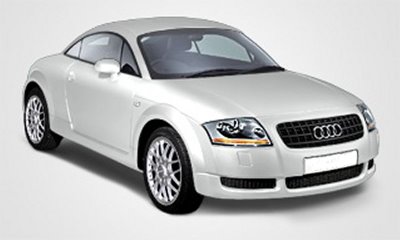 Gentex Corporation, the leading supplier of automatic-dimming rearview mirrors to the worldwide automotive industry, announced today that it has begun shipping a three- mirror, automatic-dimming mirror system for the 2007 Audi TT Coupe.
Gentex Corporation, the leading supplier of automatic-dimming rearview mirrors to the worldwide automotive industry, announced today that it has begun shipping a three- mirror, automatic-dimming mirror system for the 2007 Audi TT Coupe.



